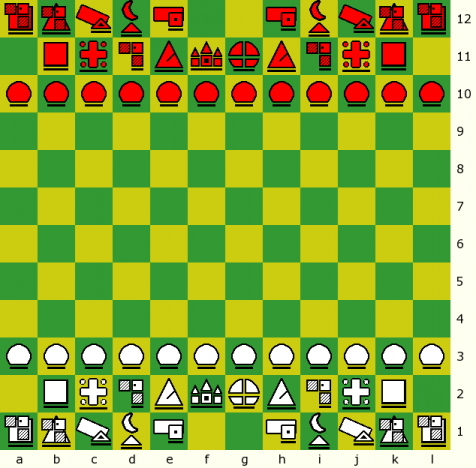Gross Chess
Some variants offer lots of novelty, and others seem to be natural extensions of Chess in one way or another. Several games, from Carrera's Chess to Grand Chess and beyond, have added the missing compounds to Chess. Chess has a Rook/Bishop compound in the Queen, but it has no Rook/Knight or Bishop/Knight compounds. Omega Chess complements the Knight with additional leapers, so that the three non-royal leapers in the game completely cover the first two perimeters and reach into the third. Eurasian Chess balances out the Rook and Bishop with a Cannon and a Vao, pieces that parallel the Rook and Bishop by moving like them except that they capture by hopping over an intervening piece. Each of these games, in its own way, seems like a natural extension of Chess. Gross Chess is a 144 square variant that brings together the pieces from these games. With extra pieces to complement all the major and minor non-royal pieces in Chess, it too seems like a natural extension of Chess but on an even larger scale than the previously mentioned games.
The name of Gross Chess principally refers to the size of the board, which is 144 squares, since 144 of something is called a gross. The word gross also means large, and this is my largest variant at present. The simplicity of the name is fitting for a game that is a natural extension of Chess to a 12x12 board. This game got its genesis when I decided to create a large variant that uses equipment I already own. I have a 12x12 board I made from ribbons, and I own two Gothic Chess sets, two Cambaluc Chinese Chess sets, an Omega Chess set, and a bunch of tournament size Chess sets. With these I created a game that uses the pieces from Chess plus the non-Chess pieces from the other sets and some additional Pawns. With one exception, every piece is used for what it was intended to be in the game it came with. The one exception is the "Cardinal" from Cambaluc Chinese Chess, which moved one space diagonally within the confines of the palace, but which I use for the Vao in this game.
One obvious advantage of using equipment I already own is that the game could be played with a physical set. Another advantage is that the game has a small learning curve, which becomes more important the larger a game gets. If you are familiar with some of the most popular Chess variants, such as Chinese Chess, Omega Chess, and Grand Chess or any one of the many Capablanca variants, then you already know most of the extra pieces in this game and should be quick to pick up the Vao, the one piece not in any of these games. Also, all of the extra pieces have been used in some of my own past games. I have used the Champion and Wizard in Wormhole Chess, the Cannon and Vao in Eurasian Chess and Yang Qi, and the Marshall and Archbishop in several of my variants, beginning with Cavalier Chess. So if you are familiar with those games, then you already know the extra pieces in this game, and the learning curve will be small for you.
Setup
M/m = Marshall, A/a = Archbishop, V/v = Vao, W/w = Wizard, C/c = Cannon,
R/r = Rook, S/s = Champion, N/n = Knight, B/b = Bishop, Q/q = Queen, K/k = King, P/p = Pawn
Pieces

King |
The King moves one space in any direction but not into check. It moves the same as it does in Chess but castles differently. |

Queen |
The Queen moves as a Rook or a Bishop, the same as it does in Chess. |

Marshall |
The Marshall moves as a Rook or a Knight. It is a popular piece in many Chess variants, dating back centuries, even before Chess as we know it today came into existence. |

Archbishop |
The Archbishop moves as a Knight or a Bishop. It is a popular piece in many Chess variants, dating back centuries, even before Chess as we know it today came into existence. |

Rook |
The Rook slides across the board in a vertical or horizontal direction, as it does in Chess. |

Bishop |
The Bishop slides across the board in any diagonal direction, as it does in Chess. |

Knight |
The Knight leaps to a space one file and two ranks away or two files and one rank away, as it does in Chess. |

Pawn |
The Pawn moves one space vertically forward without capturing, and it moves one space diagonally forward to capture, as it does in Chess. As detailed below, it can make triple moves, capture by en passant a Pawn that has made a triple move, and is subject to different rules of promotion than in Chess. |

Champion |
The Champion leaps two spaces in any orthogonal or diagonal direction, or one space in any orthogonal direction. It is a compound of the Alfil, Dababbah, and Wazir. It was introduced in Omega Chess, and it moves the same as it does in that game. |

Wizard |
The Wizard moves one space diagonally or leaps to a space one file and three ranks away or three files and one rank away. It is a compound of the Ferz and the Camel. It was introduced in Omega Chess, and it moves the same as it does in that game. |

Cannon |
The Cannon moves as a Rook but must hop over an intervening piece to capture. This piece comes from Chinese Chess and moves the same as it does in that game. |

Vao |
The Vao moves as a Bishop but must hop over an intervening piece to capture. It was created in the early 20th century as the diagonal counterpart to the Cannon. It has previously been paired with the Cannon in my earlier games Yáng Qí and Eurasian Chess. |
Rules
Aside from differences in board, pieces, and setup, Gross Chess is played like FIDE Chess with the following differences:
- As in Grotesque Chess, a King may move two or more spaces toward the Rook when it castles, with the Rook leaping over the King to the closest space the King has just passed over, so that King and Rook end up adjacent to each other. The usual castling conditions from Chess apply. A King may not castle from or through check, all spaces between the Rook and King must be empty, and neither piece may have moved before.
- As in Omega Chess, a Pawn may make an initial move of two or three spaces, and any enemy Pawn it passes by in an adjacent file may capture it by en passant on the opponent's next turn. When a Pawn captures by en passant, it moves one space diagonally forward to the file the captured Pawn moved forward in.
- As in Grand Chess, a Pawn may promote when it reaches any of the last three ranks, and it may promote only to a piece held in reserve. But there are further differences.
- The pieces held in reserve not only include captured pieces, as they do in Grand Chess, but also two Queens, four Rooks, four Knights, and four Bishops. As with Grand Chess, the main purpose is to limit promotions to physically available pieces. The pieces from two extra Chess sets are additionally held in reserve, because you will have them on hand if you have the sets the pieces in this game come from; and this number is more than sufficient to allow all Pawns to promote.
- Promotion on the tenth rank is limited to color-bound and short-range minor pieces. These are Bishops, Knights, Vaos, and Wizards.
- Promotion on the eleventh rank is limited to these pieces plus Champions, Cannons, and Rooks.
- Promotion to Archbishop, Marshall, or Queen is allowed only on the last rank.
Piece Values
While the precise values of pieces will vary for different positions, they tend to remain in the same general area thanks to fixed differences in power between the pieces. Before getting to individual pieces, let's cover types of pieces. One of the most important distinctions is between major and minor pieces. Major pieces have more endgame value, because a single major piece can, with assistance from its King, checkmate a lone King. Among the major pieces, the main distinction is between having long-range moves and having short-range moves. Even on the smaller board Chess is played on, long-range moves tend to be more valuable. On the larger board this game is played on, the greater value of long-range moves is increased. The Queen is the only piece with two long-range moves, that of the Rook and Bishop, making it the most powerful piece in the game. The remaining pieces with long-range moves are the Marshall, the Archbishop, and the Rook. Since the Rook is a major piece, and the Bishop is not, it follows that the Rook's move is the more powerful long-range move. This means that the Marshall, which moves as a Rook or Knight, is generally more valuable than the Archbishop, which moves as a Bishop or Knight. However, the Archbishop can still be a formidable endgame piece, especially because of its ability to checkmate without any assistance, a power that the Marshall does not have. Although the Rook move is generally of greater value than the Bishop move, the Archbishop has the advantage over the Rook of having two types of move available to it. This makes it a more mobile piece, capable of attacking more types of pieces without being attacked back and also more capable of escaping attack. Its Knight move also spares it from sharing the Bishop's disadvantage of being colorbound. The remaining major piece is the Champion, which has only short-range moves. While it is possible for a King and Champion to checkmate a lone King, this will usually require cooperation, which may make the Champion as ineffective as a minor piece in the endgame. In general, the values of major pieces go like this: Queen > Marshall > Archbishop > Rook > Champion.
We now come to the minor pieces. Each of these suffers from a weakness that prevents it from being a major piece. The Cannon and Vao are unable to capture a piece without the presence of another piece serving as a screen. The Wizard and Knight are short-range, and unlike the Champion, which is also short-range, none can attack two orthogonally adjacent spaces at the same time. The Bishop, Wizard and Vao are all colorbound. Of these five pieces, the Cannon, Knight, and Bishop have only one disadvantage apiece, while the Wizard and Vao each have two. The Wizard is both colorbound and short-range, and the Vao is colorbound and requires the presence of another piece to capture. This generally makes the first class of minor pieces more valuable than the remaining two. It is clear that the Cannon is more valuable than the Vao, since, aside from both being minor pieces, they differ in the same way as the Rook and Bishop. However, the Wizard has some advantages over the Knight. It is longer-range, and it has a maximum of 12 moves available to it instead of the Knight's maximum of 8. On the larger board Gross Chess is played on, the Wizard is generally more useful for attack than the Knight. Also, the Wizard is the only piece in this game that can move as a Camel, which makes it easier for a Wizard to attack another piece without being attacked back.
Although a single minor piece is insuffient mating material, another factor affecting the value of minor pieces is which combinations of two minor pieces are sufficient mating material. This is worth putting into a table.
| Piece: | Bishop | Cannon | Knight | Vao | Wizard |
|---|---|---|---|---|---|
| Bishop | On Opposite Colors | Yes | Yes | No | On Opposite Colors |
| Cannon | Yes | Yes | Yes | Yes | Yes |
| Knight | Yes | Yes | Yes | Yes | Yes |
| Vao | No | Yes | Yes | No | No |
| Wizard | On Opposite Colors | Yes | Yes | No | On Opposite Colors |
Apart from forcing checkmate, minor pieces have endgame value for preventing enemy Pawn promotion. Colorbound pieces cannot reach half the spaces on the board, and with fewer pieces on the board during the endgame, it can be harder for Cannons and Vaos to capture pieces. This leaves the Knight as the minor piece that is best capable of capturing an enemy Pawn. It moves faster than a Pawn, and it can capture a piece on any space without assistance from another piece. So, in this kind of endgame, the Knight could have greater value than other minor pieces.
Based on these considerations, endgame values for minor pieces may be (Cannon = Knight) > Bishop > Wizard > Vao.
Since minor pieces all have less value in the endgame, let's also consider their middlegame values. Some of these pieces are more useful for attack, and some are more useful for defense. The Cannon and Vao are both useful during the middlegame for capturing pieces behind enemy lines. The Wizard, making use of its Camel moves, can attack behind enemy lines from a distance. Once things open up a bit, Bishops also become useful for attacking. Thanks to the size of the board, Knights tend to be relegated to defense during the middlegame, though, of course, opportunities may arise for using them for attack. This suggests middlegame values of Cannon > Bishop > Vao > Wizard > Knight.
Note that the Vao has greater value in the middlegame and loses its value mainly in the endgame, and the Knight has lesser value in the middlegame but gains more in the endgame. The Cannon also loses value in the endgame, though that doesn't always make it less valuable than a Bishop. Taking into consideration both middlegame and endgame values, the minor pieces might be roughly estimated as Cannon > Bishop > Knight > (Vao = Wizard).
Finally, let's consider relative values between the Champion, which is the weakest major piece, and the Cannon, which is the most powerful minor piece. In the middlegame, the Cannon tends to be more valuable, because it is useful for attacking even more powerful major pieces that are otherwise safe behind enemy lines. But in the endgame, the Champion becomes more powerful, and if you have only one piece left besides your King, then a Champion is the better choice.
Computer Play
If you have version 2.0 of Zillions of Games installed on your computer, you can play this game. Download file: grosschess.zip.
You can Play Gross Chess online with Game Courier.
Equipment
You need a 12x12 board. The first image shows a board made from weaving Christmas ribbons together, and the pieces on the board come from two Gothic Chess sets, an Omega Chess set, a Cambaluc Chinese Chess set, and a couple regular Chess sets
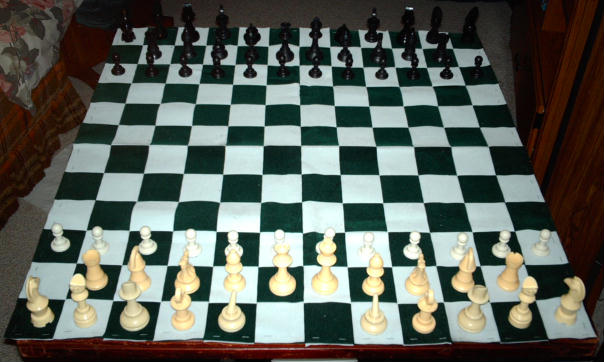
In this second picture, the board is made by cutting up mousepad-style Chess boards, as described on the Chess Variant Construction Set page, and some pieces from Musketeer Chess Variant kits replace some of the pieces used in the previous picture. In particular, the Marshall and Archbishop are represented by pieces from two Camaratta Chess kits, the Cannons are represented by Cannons from the two Musketeer Chess kits, the Vaos are now represented by the slanted Cannon pieces from Cambaluc Chinese Chess, and the Chess pieces are black and natural colored regulation Staunton pieces.

In case you can't get ahold of the sets I had when I created this game, you can get the extra pieces from some Musketeer Chess Variant kits. You can get both the Marshall and Archbishop from the Chancellor & Archbishop kit. You can get the Cannon from the Leopard & Cannon set, and you can use the Bombarde from the Griffin & Bombarde set for the Vao. You might get the Wizard from the Wizard & Wildebeest set, though it may resemble the Archbishop too much. For the Champion, you might get the Warrior from the Warrior & Mammoth set or the Amazon from the Spider & Amazon (Dragon) set. Personally, I think the Amazon looks more like a Champion, and the Warrior looks more wizardly than the Wizard. Note that the sets come in two different color options, and you will need two of each set to have two of each type of piece for each side.
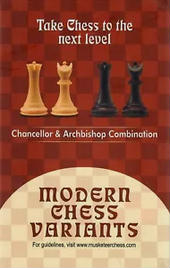
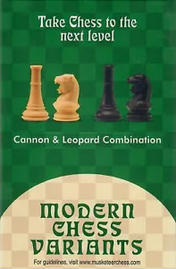

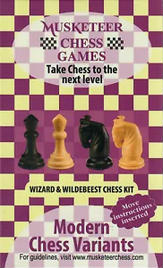
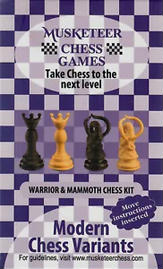
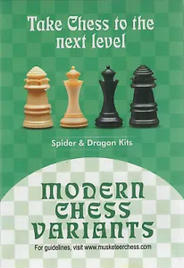
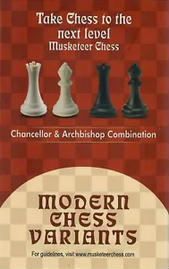
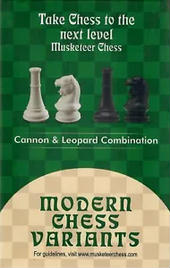
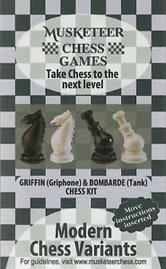
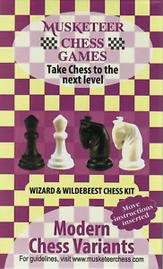
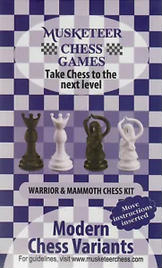
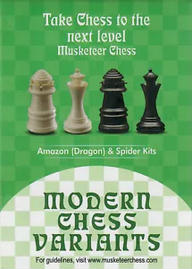
Notes
The Leapers
The Wizard and Champion from Omega Chess seem to be better complements to the Knight than other choices. I will review some other possible choices first, then return to the merits of these two pieces.
Other simple leapers. None of the simple leapers seem suitable complements for the Knight. The Ferz and Wazir, which leap only one space, are too slow and not very powerful. The Alfil, which leaps two spaces in any diagonal direction, is limited to one eighth of the squares on the board, and the Dabbaba, which leaps two spaces in any orthogonal direction, is limited to one quarter of the board. This makes them even more colorbound than the Bishop, which is limited to half the board. The leapers for the third perimeter and beyond are increasingly less useful and more awkward. Of these, the Camel (a 1-3 leaper) is the least awkward and most useful. Of all the simple leapers, the Knight is the most useful, most mobile, and most powerful.
Camel, Alibaba, and Man. These three compound leapers share with the Knight the ability to reach eight spaces. The Man covers the first perimeter, the Alibaba covers the spaces in the second perimeter not covered by the Knight, and Camel reaches into the third perimeter. The Man, which is a compound of Ferz and Wazir, is a bit too slow, especially on a 12x12 board. The Alibaba, which is a compound of Alfil and Dabbaba, is colorbound to only a quarter of the spaces on the board, half the spaces of one color. The Camel is a bit awkward to use.
Camel, Ferz+Alfil, Wazir+Dabbaba. This combination reapportions the orthogonal and diagonal leaps, so that one leaper moves diagonally, and the other moves orthogonally. Like the previous combination, all pieces have eight moves, the same number as the Knight. The two new pieces are almost just slower versions of the Bishop and Rook, which doesn't seem suitable for an enlarged variant, such as this one. Also, being so similar to short Bishops and Rooks, they seem very different from Knights, which at least has the advantage against Rook, Bishop, and Queen of being able to attack them without being attacked back. The awkwardness of the Camel remains a problem too.
The General and Pasha from Paulovits's Game (c. 1890). These two pieces are almost identical to the Wizard and Champion from Omega Chess. The General moves as a Camel or a King, which is like a Wizard with the additional power of a Wazir. The Pasha moves as an Alfil, Dabbaba, or King, which is like a Champion with the additional power of a Ferz. These pieces would not complement the Knight as well as the Wizard and Champion, because their powers of movement overlap (both moving as Kings), and they are both formidable major pieces, unlike the Knight, which is a minor piece. In contrast, the Wizard is a minor piece, and the Champion is a weaker major piece. Using these pieces instead of the Wizard and Champion might make an interesting variant, because they are simply more powerful versions of these pieces. In this variant, Pawns should gain the ability to promote to General or Pasha on the next-to-last rank.
The Pasha and Bison. The Pasha was just described above. The Bison is the compound of the Camel, already mentioned above, and the Zebra, a 2-3 leaper. The Bison can leap to any space in the third perimeter that can be reached by an angular leap. An angular leap is one that is neither diagonal nor orthogonal. For example, the Knight can make any angular leap to the second perimeter. The Bison can make any angular leap to the third perimeter. This covers the sixteen spaces in the third perimeter that a Queen's move could never reach. The Bison has the advantage over the Camel of being more mobile and more powerful. It also complements the Pasha better, because none of their moves overlap. The Pasha covers radial leaps to the first two perimeters, the Knight covers angular leaps to the second, and the Bison covers angular leaps to the third. This seems like a nice, logical division of powers between the leapers, but it makes the powers of the leapers more unbalanced. The Pasha and Bison can each reach sixteen spaces, while the Knight can only reach eight. Also, both the Pasha and the Bison are major pieces, while the Knight is a minor piece.
The Falcon and Mastodon. The Mastodon is M. Winther's name for the Pasha, already described above. The Falcon is a piece created and patented by George Duke for Falcon Chess. This piece can leap to the same spaces as the Bison, but it can do so only when it has an unblocked path of three spaces to its destination. This weakens the power of the Bison, which makes the Falcon more comparable in power to the Knight, though in the endgame it will still be a major piece. I chose to use M. Winther's name for the Pasha, because this makes it more natural to use Seirewan's Elephant and Hawk pieces for these two pieces. It might be an interesting variant of Gross Chess to replace the Champion with the Mastodon and the Wizard with the Falcon. Since Gross Chess adds some very powerful compound major pieces, adding some weaker major pieces might fill a power gap between the minor pieces and the most powerful major pieces. In this variant, I recommend that Pawns gain the power to promote to Mastodons or Falcons on the next-to-last rank.
Camel+Wazir or Alfil+Dabbaba+Ferz. These two combinations bring us closer to the Wizard and the Champion than any of the previous possibilities. They are more comparable to the Knight than the previous pieces. Each can reach twelve spaces. The Camel+Wazir is a low power major piece, while the Alfil+Dabbaba+Ferz is a colorbound minor piece. Compared to the Wizard and Champion, these pieces seem less natural. Both pieces have orthogonal and diagonal powers of movement, which makes it less natural to think of one as analogous to the Bishop and the other analogous to the Rook. In contrast, the Champion, which consolidates both one- and two-space orthogonal leaps seems more analogous to the Rook, while the Wizard, which is a colorbound piece with a one-space diagonal move and no orthogonal moves seems more analogous to the Bishop.
Overall, the Wizard and the Champion seem to be the most natural complements to the Knight. Each is more comparable in power to the Knight than most of the pieces just reviewed. The Wizard is a good piece, because it combines the reach of the Camel with the short-range maneuverability of the Ferz. Although it can reach more spaces than a Knight can, its power is diminished by being colorbound. The Champion is a low power major piece with the same range as the Knight. The Champion is a good piece, because it combines the Alibaba, which would be the natural complement to the Knight if not for its limited range, with the maneuverability of the Wazir, which can reach every space on the board.
On the Omega Chess website, there is a suggestion to use a Templar Knight instead of the Knight. As described there, a Templar Knight can normally move as a Knight or leap without capturing as a Zebra. This gives the Knight greater maneuverability on a larger board without changing how it captures. This may be used instead of the Knight in a variant of Gross Chess. Since its attacking ability is no greater than a Knight's, a Pawn should still gain the power to promote to one as soon as it reaches the last three ranks. In such a variant, Knights would be used for the Templar Knights, and the reserve would initially contain four Templar Knights instead of four Knights.
The Hoppers
The Cannon seems a natural addition to the Chess forces, because it is the primary piece from Chinese Chess that is missing in Western Chess. With the Cannon included, it is natural to also add the Vao, the diagonal counterpart to the Cannon. But there are other hoppers that could have been added instead of these. For example, the Cannon from Korean Chess could be used, along with its diagonal counterpart. The Korean Cannon hops to move and capture, not just to capture, and it cannot move at all without a screen to leap over, but it cannot use another Cannon as a screen. This last limitation is probably to prevent two Cannons from getting around by leap-frogging each other. So it should be okay to use a Korean Vao as a screen for a Korean Cannon and vice versa. Using the Korean Cannon and Vao might make for an interesting variant. But in general, I do prefer the Chinese Cannon and its counterpart, because these pieces have greater mobility than the Korean versions, which becomes more important in the endgame when there are fewer pieces.
Other hoppers have been used in fairy problems. One of the most popular is the Grasshopper, which moves along Queen lines but must hop over a screen to the space immediately behind it. The Grasshopper is weaker than even the Korean Cannon, and orthogonal and diagonal versions of the Grasshopper would be even weaker, perhaps useless in many situations. In contrast, the Vao has often proved useful in Eurasian Chess in situations where the Grasshopper would be useless, and there just seems no need to include hoppers even weaker than the Vao.
I have previously used a Cannon in Grand Cavalier Chess, which has all the compound riders used in this game, and in the same numbers too. In that game, the Cannon proved to be a very useful piece. So I think it is good to include it, and its diagonal counterpart too, in a game that includes the compound riders.
The Compound Riders
The compound riders used in this game, the Marshall and Archbishop, are the two most popular pieces in Chess variants. Since they move like pieces already in Chess, they are easier for beginners to learn and use. The other new pieces added to this game suggest the possibility for more compound pieces, but this game has enough pieces without them, and it is best to learn these pieces before using their compounds. Another compound rider not used in this game is the Amazon, which can move as a Queen or Knight. This piece can force checkmate on its own, which makes it a bad piece to use. Although the compound riders added to this game are powerful, none is more powerful than the Queen.
Written by Fergus Duniho.
WWW page created: November 29, 2009
